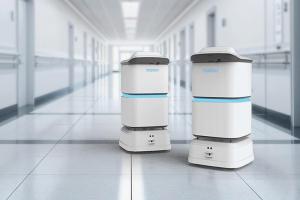Infant abduction prevention systems
Infant abduction-prevention systems have evolved in recent years to better protect families’ “precious cargo” during that critical time period between birth and departure.
While the core concept of tags and alerts remains the same, total system capabilities have reached a whole new level.
The goals: to foil abduction attempts, match mothers to their babies, locate wandering patients and track high-value assets.
Real-time protection
The newest infant protection technologies work with Wi-Fi networks to provide campuswide, real-time information on an infant’s location and status, while connecting to platforms and devices that already exist within staff and patient processes. These include medical record platforms, nurse call systems and such mobile devices as smartphones.
What were once stand-alone systems with an audible alarm are now server-driven systems that facilitate notification and reporting. Infant transmitters have evolved as well. New, soft banding material incorporates cut-band detection and has the ability to determine if a transmitter has been removed from skin contact, which offers a high degree of security against tampering.
“Infant tags have traditionally been large and heavy, making them cumbersome to mount on the small limbs of newborns,” says Doug Stevens, vice president of sales and marketing, Guard RFID Solutions Inc., Delta, British Columbia. “Ongoing miniaturization of integrated circuits as well as new advances in antennae and other radio-frequency-related technologies have allowed new tag designs to be smaller and lighter, and better suited for these applications.”
While the core concept of tags and alerts is the same, the infrastructure in hospital facilities and the software/user computer interface has changed, experts agree. With smaller batteries and longer battery life, new tags are smaller and last longer. The bands, which are the most tangible piece of infant abduction-prevention systems, are softer. At the same time, most infant protection systems now can be extended beyond their core to other subsystems and technologies, such as smartphones, through specific apps.
“The biggest evolution is moving from a single personal computer (PC)-centered system to a more distributed system,” says Mohsen Hekmatyar, director, Elpas Americas, Tyco Security Products, Westford, Mass. “The older systems required a networked PC to function with all alarms being sent to a single station. They were rendered useless during a network or computer failure. Now, more state-of-the-art systems utilize a distributed architecture to ensure that the system can perform its core functions of locking doors and sounding alarms without relying on a network or a PC.”
Stand-alone vs. integrated
Most vendors offer stand-alone infant abduction-prevention solutions that can integrate with other technologies. However, many remain stand-alone point systems based on unique protocols and operational structures, which can present a problem.
Stand-alone systems offer greater security and less risk of getting hacked or losing patient information, according to Rick Dorrell, RCDD/NTS OSP, technology consultant with Sparling Inc., Lynnwood, Wash. However, this configuration adds servers that need hardware maintained and refreshed every three to five years. Most hospital information technology (IT) departments prefer not to add separate systems because of the proprietary software and system components.
“Manufacturers that offer infant protection solutions as an add-on component offer an ease of integration that can pose problems in the stand-alone system’s security makeup,” Dorrell explains. “All infant protection solutions need to interface with the hospital’s security systems to some extent — the fire alarm for door lockdown, delayed egress and perimeter alarm and elevator lockout capability — if needed. Hospitals with more advanced electronic safety and security systems can interface with video surveillance once an alarm is activated.”
RF Technologies, Brookfield, Wis., offers the Safe Place Infant Security Solution as a stand-alone unit that can be incorporated into a complete solution through integrations. “The issue of interoperability is the key,” says Tim Fischer, vice president of sales, hospital business unit. “For instance, if a facility wants to use the system and chooses another vendor’s asset-tracking system, it has that ability. We allow them to integrate into their own solutions such as wireless phones, pagers or access control.”
Hospitals want to do more complex integrations, such as to the admission, discharge and transfer system, to automatically pull in patient data and reduce duplicate data entry, according to Steve Elder, senior marketing manager, Stanley Healthcare, Waltham, Mass. “For that, you need an enterprise-grade solution that resides on the hospital’s IT network and provides hospitalwide visibility. The more applications you can run on the same infrastructure — such as patient security, environmental monitoring and clinical workflow solutions — the lower the costs to deploy and support.”
“For many years, the infant abduction solution market segment has been stagnant, relying on proprietary [radio-frequency identification] technology,” adds Mark Kosloski, president, McRoberts Security Technologies, Freehold, N.J. “Only recently has there been a surge of development focused on convergence with Internet Protocol (IP) networks, leveraging existing IT infrastructure.”
Vendor consolidation
Consolidation among manufacturers in this market segment has been prevalent in recent years, according to Dorrell. “There were 12 to 15 integrators five years ago, at a time when infant protection peaked as a hot-button issue for hospitals,” he says. “That number is down to seven or so now, with many vendors branching out into other venues.”
McRoberts Security Technologies is one. The company’s MyChild Infant Protection System is installed in hundreds of health care facilities nationwide. “We have moved beyond an infant abduction solution in a single unit, and have expanded tracking to all patients to prevent abduction, elopement and wandering throughout the facility, ensuring that infants are monitored during transport between units,” says Kosloski.
It is critical that a matching system be in place when an infant leaves the custody of the parent, he adds. “Our umbilical tags, cord clamp, baby band and parent bands are numbered to match. The bands are embedded with a near-field communication tag. Our mother-baby matching mobile application provides confirmation that the infant is indeed being placed with the correct mother.”
RF Technologies has 450 active installations within health care facilities. The company’s Safe Place Infant Security Solution, which was developed by nurses, is a customizable solution that can fit the needs of hospitals of all sizes. “It is a non-exciter-based system, which means that its essential components operate independently of the server,” Fischer says. “So, in the event of a server shutdown, the perimeter doors and elevators are still protected.”
Secure Care Products LLC, Concord, N.H., has some 8,500 customers across the United States and internationally. The company’s MatchMAKER ID system works with its KinderGUARD infant security solution to offer a discrete mother-baby matching system that ensures that the correct infant is brought to the mother. Another technological development is the system’s ability to work on three different frequencies, which allows it to be integrated without interference while existing technologies are already in place.
Stanley Healthcare’s Hugs infant protection system protects 1.5 million babies across 1,400 hospitals worldwide. With the latest Hugs solution, it is possible to monitor infants anywhere that the hospital has Wi-Fi coverage, even in the parking garage. “Until now, many facilities found it economically feasible to cover only a small part of the hospital — typically, the maternal child care area,” says Elder. “Beyond that point, there was no visibility into the location of infants.”
It is not unusual for two different areas of the hospital that need protection — such as the labor and delivery and postpartum units — to be physically separated. Because covering the space between those areas can be expensive, many hospitals aren’t directly able to address this issue. “With Hugs Wi-Fi, this security gap is closed, and infants are monitored all the time,” Elder adds. “Also, hospitals can track the movement of an abductor beyond the maternal child care area, saving security staff critical time.”
Tyco Security Products has infant abduction-prevention system installations worldwide, with some of the larger in the Midwest and central Canada. Tyco Security Product’s Elpas Charm is a soft band that supports two years of battery life. It incorporates a local controller-based solution using ultrahigh frequency and low frequency. This allows for offline operation as well as online connection to a user interface via Web browsers or handheld devices. Notifications can be sent directly to Apple and Android devices.
Guard RFID Solutions has installed more than 100 infant abduction-prevention systems, most of which comprise its TotGuard Infant Security solution, in hospitals in the United States, Canada, Mexico and Saudi Arabia. TotGuard is a component of the company’s AllGuard Integrated Security for Healthcare family of products. The system consists of a server that is interfaced to a network of tag readers using Ethernet connections.
“The system uses all three tag technologies available today — umbilical, sensor-based tamper detecting and cut-band tamper detecting,” says Stevens. “These tags transmit periodic messages that are received at various tag readers in the coverage area. By means of a special algorithm, the tag location is determined using information within the beacons, allowing for real-time location capability within the system.”
False alarms are the most significant reason for user complaints and system nonacceptance. Most false alarms are due to unreliable tamper-detection mechanisms. Other causes are proximity of egress points to patient rooms and patient ambulation. “It is important for vendors to work closely with hospitals to understand their workflow and provide a system design that minimizes or eliminates these types of alarms,” Stevens notes.
Much depends on how one defines a false alarm, according to Hekmatyar of Tyco Security Products, because some classify events as false alarms even when the technology is performing as it was designed. For example, with a band that employs skin-sensing, an alarm may sound when water gets in between a band and the baby’s skin during a bath. In such a case, the technology correctly identifies that something is between the band and skin, which is what the technology is meant to do.
“The staff member may identify this as a false alarm, though it really is what could be called a nuisance alarm,” he explains. “Some hospitals require their staff to check the infant tag each time they visit a baby’s room to ensure that it is attached correctly and to prevent nuisance alarms.”
Coming attractions
Looking ahead, experts see increased enterprisewide visibility, reliance on IP-based technology, tighter integration with other security products, fewer false alarms and better tag options.
The most important developments taking place today revolve around the creation of standards that allow for interoperability and data-sharing between different systems used within health care environments. Consolidation of these technologies will revolutionize the way infant security solutions will function.
Neal Lorenzi is a freelance health care writer based in Mundelein, Ill.
 | Wireless wonderThe small, wireless tag protects the infant against abduction and can be paired with a mother’s tag for correct mother-infant matching. |
 | Situational awarenessThe Elpas Charm provides real-time indoor positioning data so that medical personnel always know the location, movement and status of the protected infant. |
 | Mobile operationThe Safe Place Infant Security Solution allows staff to receive alerts at a central computer station or via a variety of mobile devices. |
 | No false alarmsThe KinderGUARD infant transmitter is designed to offer high-quality, cut-band protection while decreasing false alarms. |
 | It’s a matchThe MyChild infant protection umbilical tag and clamp features a mother-baby matching mobile application. |




